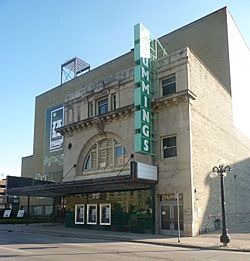Burton Cummings Theatre facts for kids

Burton Cummings Theatre
|
|
| Full name | Burton Cummings Theatre for the Performing Arts |
|---|---|
| Former names | Walker Theatre (1907-33); (1991-2002) Odeon Theatre (1945-91) |
| Address | 364 Smith St Winnipeg, MB R3B 2H2 |
| Location | Central Park |
| Owner | True North |
| Capacity | 1,638 |
| Construction | |
| Opened | 18 February 1907 |
| Renovated |
|
| Closed | 1933-45 |
| Reopened |
|
| Architect | Howard C. Stone |
| Website | |
| Official name: Walker Theatre National Historic Site of Canada | |
| Designated: | 1991 |
The Burton Cummings Theatre is a famous theatre in Winnipeg, Manitoba, Canada. It was built by a local show organizer named Corliss Powers Walker. When it first opened, it was called the Walker Theatre. In 2002, the building was renamed to honor Burton Cummings. He is a well-known singer-songwriter who grew up in Winnipeg.
Contents
History of the Theatre
Corliss Powers Walker owned several theatres in South Dakota. These theatres were located along a railway line that ended in Winnipeg. Walker worked with a big Broadway company from New York. This partnership helped bring popular Broadway shows to his theatres. His group of theatres was known as the Red River Valley Theatre Circuit.
Building the Walker Theatre
The land for the theatre was bought in July 1905. The theatre itself was built between 1906 and 1907. It might have opened earlier, but a workers' strike caused delays. The Walker Theatre officially opened on February 18, 1907. The first show was an opera called Madame Butterfly.
A Montreal architect named Howard C. Stone designed the theatre. He was asked to make it fireproof. This was important because of several bad theatre fires at the time. The theatre was originally planned to be part of a larger building complex. This is why its outside walls look plain. The other buildings were never finished. The first cost to build the theatre was $250,000.
Inside the Theatre
The inside of the theatre was very fancy. The main hall, lobby, and lounges had Italian marble. They also featured beautiful plasterwork, gold trim, and soft velvet carpets. There were silk tapestries, painted murals, and sparkling crystal chandeliers. The main hall could seat 1,798 people.
The ceilings inside were very high, reaching about 18 meters (60 feet). There were huge arches on the side walls and two curved balconies. The top balcony was for cheaper tickets. It had steep rows and wooden bench-like seats. Ticket prices ranged from 25 cents for balcony seats to $2.00 for seats closer to the stage. The balconies were built without pillars. This meant everyone had a clear view of the stage. The stage area was about 25 meters (82 feet) wide and 12 meters (39 feet) deep. It was also 21 meters (69 feet) high. Behind the stage, there were three floors of dressing rooms and storage areas.
Safety Features
The theatre was built to be very safe from fires. This was because of terrible theatre fires that had happened in North America. For example, the 1903 Iroquois Theatre fire was a big concern. The Walker Theatre had many safety features. It had a strong steel frame. Many parts were covered in concrete or special fire-resistant clay. The floors were concrete with fire-resistant wool carpets. There were metal doors that could stop fires between rooms. Brick and terracotta walls also helped prevent fires from spreading. The stairways were made of metal covered in slate. Corliss Walker said it was the first fireproof theatre in Canada.
Early Uses and Changes
The first show at the theatre was on December 17, 1906. This was even before the building was fully finished. A group called Pollard's Lilliputian Opera Company performed. The theatre was used for live shows until 1933. It also hosted political meetings during this time. These included events for workers' rights and women's right to vote. Famous people like Nellie McClung took part in debates there. In 1918, a political meeting at the theatre helped lead to the Winnipeg General Strike.
In 1933, the theatre closed because of the Great Depression. This was a time when many people lost their jobs and money. In 1936, the City of Winnipeg took over the theatre because taxes had not been paid. In 1944, a theatre owner named Henry Morton bought it. A Canadian movie company turned it into a cinema in 1945. During this change, many of the original decorations were covered up. A false ceiling was added to close off the upper balcony. The first movie shown there was Blood on the Sun on November 3, 1945.
In 1990, a non-profit group bought the theatre. They worked to bring back its original look. It reopened for live performances in March 1991. In 2002, it was renamed the Burton Cummings Theatre.
The theatre was recognized as a National Historic Site of Canada in 1991. It was also named a Provincial Heritage Site that same year. In 2017, the signs on the front of the building were updated.
New Management
In May 2014, a local company called True North Sports & Entertainment started managing the theatre. They took over running the building and made important repairs. As part of this agreement, a new group was formed to guide the theatre. This group included members from True North and other local organizations. In spring 2016, True North bought the building from the previous non-profit group.


